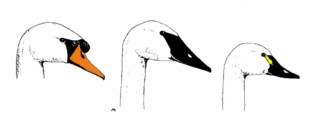MI DNR wants help with Trumpeter Swan census
 During August and September 2005, the Michigan Department of Natual Resources would like to hear about Trumpeter Swan (Cygnus buccinator) sightings to help with a broad, North American trumpeter swan census.
During August and September 2005, the Michigan Department of Natual Resources would like to hear about Trumpeter Swan (Cygnus buccinator) sightings to help with a broad, North American trumpeter swan census.
Trumpeters are protected in Michigan as a 'threatened species' - a large improvement from being considered extinct back in 1885. Efforts have been underway since the late 1980s and early 1990s to reintoduce and restore the native species' population size and distribution in Michigan (and elsewhere) through the North American Restoration Plan. The program first attempted to cross-foster trumpeter eggs with mute swans, but this resulted in very low success rates and this approach was quickly abandoned. In the next phase, egg collection from confined pairs, artificial cygnet hatching, rearing and release proved much more successful. Birds were initially released at Seney Wildlife Refuge in the upper penninsula, at the Rifle River Recreation area near Rose City and at the Kellogg Biological Station Bird Sanctuary in Hickory Corners. In 1992, the first natural reproduction in 100 years was recorded with these released Trumpeters. Birds have naturally dispersed from these initial loci, but the highest concentrations are still found eastern UP, and in the northeast and southwestern Lower Peninsula with smaller populations scattered across the state. The population is now around 650 birds statewide.
So keep you eyes open for these large, beautiful birds. It is important to record your observations accurately, because Trumpeter Swans can easily be confused with Mute Swans, which are also found throughout Michigan but are not being counted. There are a couple of important differentiating features for these two species:
From left to rignt: Mute, Trumpeter and Tundra Swan heads
MI DNR request that you should report your sightings according to the location of your observation as follows:
Southern LP: Joe Johnson, MSU Kellogg Bird Sanctuary (269-671-2511); Northeast LP: Elaine Carlson, DNR (989-826-3211 x 7030); Northwest LP: Ruthann French, DNR (231-775-9727); Eastern UP: Kristie Sitar, DNR (906-293-5024); Western UP: Alisa Bartos, USDA Forest Service (906-265-5139 x 33) and Brian Bogaczyk, USDA Forest Service (906-932-1330 x 509). People submitting reports should be prepared to provide the specific location and date of observation. Information on single swans, pairs, pairs with young, and flocks with three or more swans will be useful. Only observations made during late summer 2005 should be reported.
For more information on Trumpeter Swans, visit the Kellogg Biological Station website here or here.
The Fly Fishing Loop is sponsored by flydepot.com
[ Home Waters | Next | Random | List | Search ]

This work is licensed under a Creative Commons Attribution-NonCommercial-ShareAlike 2.5 License.





